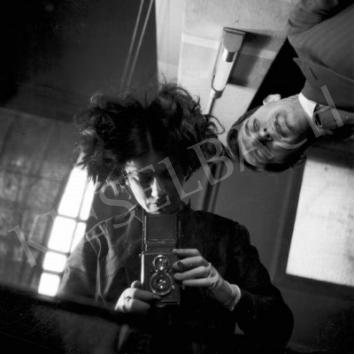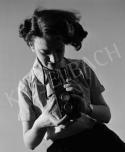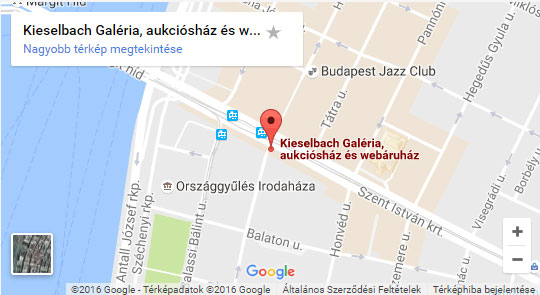Eva Besnyő Budapest, 1910.04.29. - 2003.12.12., Laren, Netherlands
She comes from a bourgeois civilian family. She lived in a house in Budapest, at 10 City Hall Street, with her three siblings and her lawyer parents, with Andrew Friedmann, later Robert Capa, who was in love with all three Besnyő girls. In this time Capa was 12, she was 15 years old. In 1928 she graduated from Veres Pálné High School, and then visited József Pécsi's private photo school for two years. Social sensitivity characterized her photos from the beginning, photographed sociophotos from 1929, photographed homeless people sleeping on benches.
1930: after her exams by Pécsi, she moved to Berlin with the press release of the Hungarian Theater in her pocket. Shewas employed by Renée Ahrlé's advertising studio. The following year she worked for dr. Peter Weller as a photojournalist, and many pictures of Éva Besnyő appeared with Weller's signature in the Berliner Illustrirte Zeitung.
By the summer of 1931, she got tired of publish under another name and opened an independent portrait studio. She is in contact with the left-wing colony of Hungarian emigrant youth, her best friends are György Kepes and the later Robert Capa, that time Endre Friedmann. Neofot publishes her reports (via Berliner Tageblatt, Querschnitt, Woche). During her short two-year stay in Berlin, she created the best works of her career. The spirit of Bauhaus, László Moholy-Nagy and Alexandr Rodchenko have shaped her artistic vision. 55 years later, Kepes and Besnyő also made a photo album of their pictures taken in Berlin.
1932: In London (The Modern Spirit in Photography), she married a Dutch cameraman John Fernhout and settled in his home country, walking the way of many Jewish left-wing intellectuals. This year she returned home,to Hungary, photographing servants and peasants with his husband at the slumcalled Kiserdő.
1934-1939: she had a studio in Amsterdam with Carel Blazer.
Her pictures were distributed by ABC Press, whose founder was Imre Róna.
From 1934: she was a member of the BKVK (Association of Arts for the Protection of Cultural Rights). She made architectural photographs for the members of De 8 en Opbouw.
1937-1939: she made photo walls for passenger ships.
1941-1944: during the German occupation of the Netherlands, she could not work because of her Jewish origin, hiding with false papers, making ID cards in villages for food.
After 1945 she raised her children, for a while she doesn’t participate in artistic life, but in 1952 she was a member of the Family of Man exhibition in New York.
1953: she opened her exhibition at the Museum of Modern Art in New York.
1958: she won a gold medal at the first Venice Biennale.
1970: she became a feminist fighter in the Netherlands, documenting it with her photographs.
1974: she commissioned a series of photos about the Women's Occupations, commissioned by the Art Foundation of Amsterdam.
1975: she published a book titled You girl, I just got a really consciousabout the first five years of Dolle Mina.
She had many exhibitions from Budapest trough Amsterdam to the United States.
1994: she received the Lifetime Achievement Award from the Dutch Ministry of Culture.
Exhibitions:
1933: Van Lier Galeria, Amsterdam; Rotterdam, Utrecht; 1980: Portrait of Dutch artists, Steedelijk Museum, Amsterdam; 1981: Artist’s Portraits, Netherlands Institute, Paris; 1986: The work of half a century, Art Gallery, Budapest, 1998: Photo exhibition of Eva Besnyő. Fészek Artist Club, Budapest. 1999: De Nieuw Amsterdam– en varend kunstwerk. Chabotmuseum, Rotterdam, The Netherlands; Hommage á Eva Besnyő Amsterdam, (The Netherlands); 2003: Éva Besnyő, the grande dame of photography. Spinoza Gallery Budapest, 2008: ATA & EVA HUP Gallery Amsterdam (The Netherlands); (Exhibition by Éva Besnyő and Ata Kandó)
Honors, awards:
1957: Venice Photo Biennial, gold medal, 1994, Lifetime Achievement Award from the Dutch Ministry of Culture. 1999: Erich Salomon Award from Deutsche Gesellschaft für Photographie
Books: Several books and photo albums appeared in her works. Photographie 1939. Arts et Métiers Graphiques, Paris. 1936. Tibor Bodrogi: The Art of Indonesia, Budapest, 1971. (Photos: Éva Besnyő, Ata Kandó, Károly Koffán, Károly Szelényi) 'N Halve eeuw werk. Amsterdam, 1982. Willem Diepraam: Eva Besnyő. Fragment, Amsterdam, 1993. Eva Besnyő, Filip Bool, Willem Diepraam, Karen Gamester: Eva Besnyő. Focus Uitgeverij Amsterdam, 1999, Tineke de Ruiter-Éva Besnyő: Besnyő in Bergen. Voetnoot, Amsterdam, 2000.












